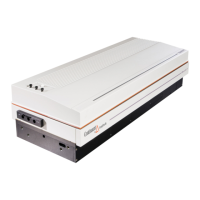36
SECTION 5: TROUBLESHOOTING
SYMPTOM #1: Electronics Do Not Lock
POSSIBLE CAUSE:
Piezoelectric element disabled.
REMEDY:
Verify that the Mode Switch is in AUTO. Check piezoelectric connection and installation in
high reflecting mirror mount.
POSSIBLE CAUSE:
Q-switch BUT circuit not receiving proper signals: Trigger and Photodiode LED does not
flash at 1/2 the host repetition rate.
REMEDY:
Check Q-switch trigger signal into seeder. Check photodiode pulse at pin 6 of the Diagnostic
Connector (located on the top of the laser head). Signal at pin 6 should go high (5V) to low
and stay low for >1.0 µsec, thus indicating that the photodiode has received enough light to
be well saturated. If pin 6 does not stay low, check the spatial mode overlap and photodiode
alignment.
SYMPTOM #2: Excessive Power Drop in 1.06 µm Pulse Output when Seeded.
POSSIBLE CAUSE:
Frequency overlap not optimal.
REMEDY: See Section 2.2.4
POSSIBLE CAUSE:
Excessive spatial hole burning in host oscillator.
REMEDY:
Check alignment of quarterwave waveplates. If this does not solve the problem, the
waveplates are defective or the Nd:YAG rod is excessively birefringent.
SYMPTOM #3: Excessive Timing Jitter in Seeded and Unseeded Output Pulses.
POSSIBLE CAUSE:
Host laser has insufficient holdoff.
REMEDY:
Check holdoff condition of the host laser with the rejected beam blocked any of the alignment
mirrors (before mirror #3 per"typical" arrangement, shown in Figure 2-6). This checks the
holdoff of the host laser totally decoupled from the seeder. Holdoff should be strong with a
large margin for increasing the flashlamp energy before breakthrough occurs (if ever).
Next, unblock the rejected beam and recheck the holdoff condition. If holdoff is notably worse
than with the rejected beam blocked, reflections off of the alignment mirrors or seeder
telescope may be responsible.

